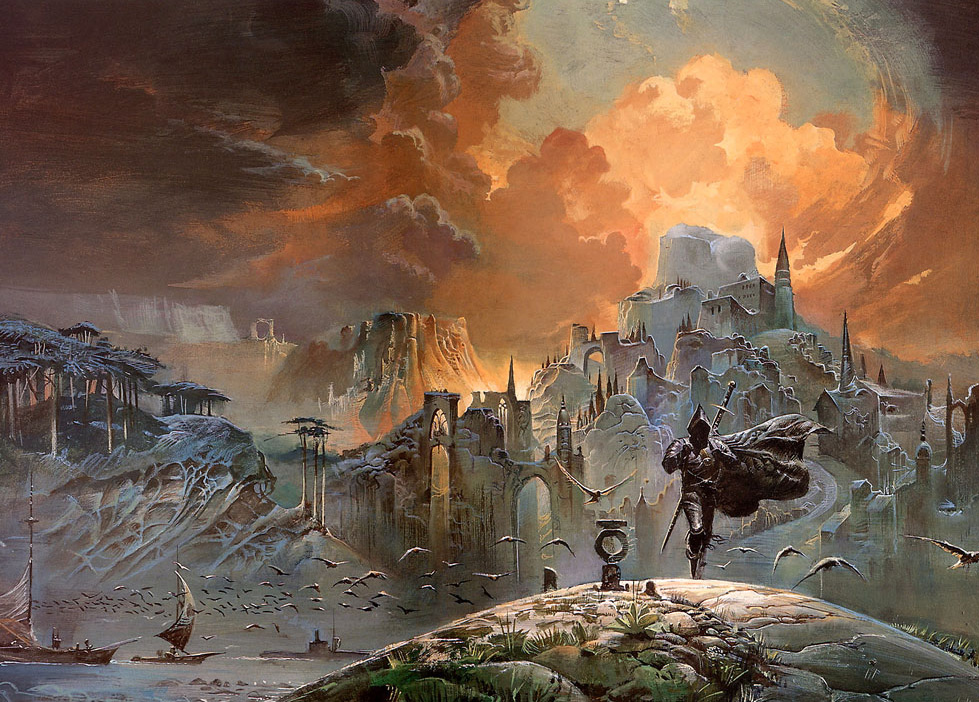Gene Wolfe was a devout Catholic, and he writes like it. The Book of the New Sun (1980) series is gothic, seedy, and tortured, with prose that are impassable at times. Reading his books is like being in a dark catacomb and feeling your way against a mossy wall to the center. His novels are often so hard to read, fans have created podcasts to shaman you through the experience.
Gene Wolfe is something of a religious figure himself, having amassed a dedicated following of disciples who have written blogs, books, glossaries, and dictionaries to expand the worlds that Gene Wolfe created. He was also beloved among writers until his death, including his friend Ursula K. Le Guin, who called Wolfe “our Melville.”
The Book of the New Sun is set in the far future on a dying Earth – called Urth – that has regressed into a dog-eat-dog medievalism.
Part of what makes this book so hard to read is that the reader is presumed to already understand this world, and we are spared any exposition that might illuminate its setting. Furthermore, as Gene Wolfe explains at the beginning of the book, he’s merely a translator, and The Book of the New Sun is only an imperfect retelling in English. Inventing words is a trademark of Wolfe’s, and this entire series operates on a fantasy lexicon.
But one of the most infamous hallmarks of Wolfe’s writing is his reliance on dishonest narrators to tell the story. Severian, the protagonist of Book of the New Sun, makes the reader feel like the priest on the other side of the confessional – so sinful, sociopathic, and self-absorbed is this guy. There’s an irony about “unreliable” narrators in fiction, and Wolfe knows it – in fiction, everything is as true as the next thing – against what standard is his truth-telling judged?
The reader only becomes aware of the mechanics of the world and the plot of the story through easter eggs that slowly reveal that Urth is actually our world, and we are the ancestors in this story.
The picture he was cleaning showed an armored figure standing in a desolate landscape. It had no weapon, but held a staff bearing a strange, stiff banner. The visor of this figure’s helmet was entirely of gold, without eye slits or ventilation; in its polished surface the deathly desert could be seen in reflection, and nothing more.
The Shadow of the Torturer
One of the more famous passages in this book describes a photo that appears to be of the 1969 Apollo 11 moon landing, establishing the setting of the story as our Earth. It’s important to remember that this would have happened a year before this book was published, though now, in 2021, the moon landing seems so far in the past that conspiracy theorists debate its veracity.
The Book of the New Sun was Gene Wolfe’s response to Jack Vance’s seminal sci-fi series Dying Earth, which was first published in 1950. The Dying Earth series founded the namesake genre of sci-fi, inspired writers like Wolfe and George R. R. Martin, and even provided the framework for a lot of the systems and conventions in Gary Gygax’s Dungeons & Dragons.
But when people say “genre fiction,” Vance’s Dying Earth is exactly what they’re talking about. All the women are written as if the only source material that preceded this book were Looney Toons and the Bible. The men are proud punishers of Monsters and Evil, and they love fucking, killing, and riches (and not much else). In Dying Earth, science is the same thing as magic – which actually wasn’t a new concept in 1950, but a doctrine dating back to at least the Middle Ages. There are a lot of things that are very fun about Vance’s novels, but they are peak camp.
So Gene Wolfe’s spin-off is actually more enjoyable in a lot of ways. It’s not about the “hot dog!” flashiness of wizards and damsels in distress, but about highly stylized language and a baroque aesthetic of a dying world.
I would recommend these books to two types of readers:
- Hard-core science fiction readers who are looking for something different and challenging
- Avid readers of Pynchon, Shakespeare, Borges, Faulkner, or fans of labyrinthine prose
